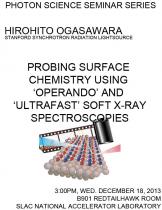Hirohito Ogasawara, SSRL
Chemistry on the surface of materials is a key enabler in developing advanced energy technologies like fuel cells, fuel production catalysts. We are working towards better understanding of the surface and interfacial properties of materials. State-of-art soft x-ray spectroscopy instruments at SLAC provide researchers both a broader and a deeper understanding of what happens during chemical reactions at the surfaces of materials.
The sluggish kinetics in oxygen reduction reaction (ORR) is one of key challenges in fuel cells. Through the use of ambient pressure x-ray photoelectron spectroscopy (APXPS) at SSRL, we identified the surface speciation of the fuel cell Pt cathode under different operating conditions. We established that the species on the electrode and the favor ORR pathway change drastically depending on the degree of humidification.
New possibilities for the study of chemical reactions on surfaces using LCLS will be presented. We followed the ultrafast evolution of the bond distortions, weakening and breaking, using x-ray emission spectroscopy resonantly tuned to the oxygen core level with ultrashort x-ray pulses. We can directly study the time evolution of the molecular orbitals in an atom-specific way on a sub-picosecond timescale. Different adsorption configurations of CO and O were characterized by comparing the measured time-dependent changes of the molecular orbitals.





